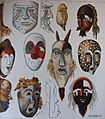Les Demoiselles d'Avignon facts for kids
Les Demoiselles d'Avignon (which means The Young Ladies of Avignon) is a famous painting created by Picasso in 1907. It's a key work in the art style called Cubism. This large painting is now kept at the Museum of Modern Art in New York City.
The painting shows five women. Each woman's face and body are painted in a different style. The woman on the far left looks like she might be from ancient Egypt or southern Asia. The two women next to her are painted in a style inspired by Iberian art from Picasso's home country, Spain. The two women on the right have faces that look like African masks. Picasso was very interested in African art at that time. The women's bodies are not painted realistically; they are stretched and have sharp, angular shapes, making them look very striking.
Contents
How Picasso Created the Painting
Picasso made many drawings and studies before he painted Les Demoiselles d'Avignon. He often said that Spanish art and Iberian sculpture were big influences on this painting.
African Art's Influence
In October 1906, Picasso spent an evening looking closely at a Teke figure from Congo. This figure was owned by another famous artist, Henri Matisse. It was after this night that Picasso started his first drawings for what would become Les Demoiselles d'Avignon. Many art experts believe that Picasso also visited the Musée d'Ethnographie du Trocadéro (a museum of world cultures) in Paris in 1907. There, he saw and was inspired by African and other non-European artworks just before he finished his painting.
When the Painting Was First Shown
When Picasso showed his large painting (it's about 8 feet tall!) in his studio, some other painters and art critics were very surprised and even upset. Henri Matisse thought it was a joke.
The Start of Cubism
According to Daniel-Henry Kahnweiler, an art dealer, Les Demoiselles d'Avignon was the beginning of Cubism. He said that Picasso started this strange, large painting in early 1907. Kahnweiler noted that parts of the painting, especially a crouching figure and a bowl of fruit in the front, were drawn with sharp angles. The colors were bright blue and yellow, next to pure black and white. He believed this was the start of a new art style.
Impact on Modern Art
Even though Les Demoiselles d'Avignon had a huge effect on modern art, its influence wasn't immediate. The painting stayed in Picasso's studio for many years. It wasn't shown to the public until 1916. It only became widely known as a groundbreaking artwork in the early 1920s. This happened when a writer named André Breton wrote about it. The painting was later shown again in an art magazine called Cahiers d'art in 1927, in an article about African art.
Today, Les Demoiselles d'Avignon is considered one of the most important paintings of the 20th century.
Images for kids
-
Paul Cézanne, Bather, 1885–1887, Museum of Modern Art
-
Henri Rousseau, The Hungry Lion Throws Itself on the Antelope, 1905
-
African Fang mask, similar to those Picasso saw
See also
 In Spanish: Las señoritas de Avignon para niños
In Spanish: Las señoritas de Avignon para niños







